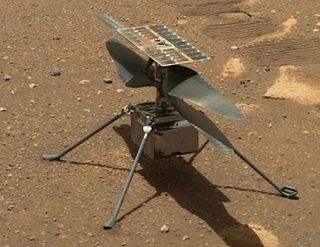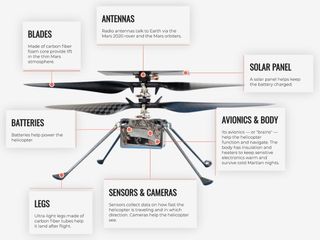NASA is mapping out plans for bigger, more capable Mars helicopters
The Mars Science Helicopter could do a variety of work on the Red Planet.

Given the highly successful and ongoing flights of NASA's Ingenuity Mars helicopter, engineers are turning their attention to future aerial craft for the Red Planet.
One concept is the Mars Science Helicopter, advocated as a way to greatly expand the exploration zone on Mars — including possible deep dives into Red Planet caves.
Researchers have already gleaned loads of technical information from Ingenuity's off-Earth flights, steadily pushing its capabilities. Now they want to use that data to push for development of a new aerial system for Mars investigation.
Video: Watch NASA's Mars helicopter Ingenuity fly in 3D

Blow the doors open
"Ingenuity is a technology demonstrator. Our core goal, our prime directive, is to prove that we can fly on Mars…to have that Wright Brothers moment for the first time and hopefully blow the doors open for the future exploration capabilities on the Red Planet," said Ingenuity operations lead Theodore Tzanetos of NASA's Jet Propulsion Laboratory (JPL) in Southern California.
Tzanetos provided a review of Ingenuity's flights to date and a preview of future sorties, and he also laid out the basics of a possible follow-on Mars aircraft. He spoke during a June 21 virtual gathering of the Mars Exploration Program Analysis Group (MEPAG), which is responsible for providing science input needed for NASA to plan and prioritize Mars exploration activities.
Ingenuity came into being thanks to a small but passionate team, Tzanetos emphasized, that involved JPL, AeroVironment, Inc., NASA's Ames Research Center in Silicon Valley, Qualcomm, NASA's Langley Research Center in Virginia, and SolAero.
Get the Space.com Newsletter
Breaking space news, the latest updates on rocket launches, skywatching events and more!
Since Ingenuity's first flight on April 19, "we have been collecting a treasure trove of engineering data," Tzanetos said. "Every one of the flights afterwards was built on that [first] success."
As of Tuesday (July 13), Ingenuity has flown nine times on the Red Planet.
Extended mission
Ingenuity made its debut flight in April, a roughly 30-second affair from takeoff to landing. The little chopper aced four additional flights over the next few weeks, wrapping up its original technology-demonstration mission in early May.
Ever since then, the craft has been flying in an extended mission phase designed to show the scouting potential of Mars helicopters. The plan calls for flying around two times a month, with a smaller team of operators here on Earth.
"The focus is to try and become as efficient as possible," Tzanetos said during his MEPAG talk. "We're really starting to stretch our wings, so to speak, in the distances, flight times and height above ground level."
Meanwhile, flights of the Mars airborne machine have yielded other firsts. One of those is use of the copter's navigation imagery melded with NASA's Mars Reconnaissance Orbiter images of Jezero Crater, where Ingenuity touched down with NASA's Perseverance rover this past February.
Doing so showcased that Ingenuity is able to produce high-resolution imagery downfield. For example, Ingenuity operators found, after the fact, that color images of Jezero's Séítah geologic unit — a sandy stretch of terrain that is viewed as tough for Perseverance to traverse — led to "serendipitous science targeting" of value to rover operators, Tzanetos said. "The scouting capability is what we hope to explore a bit more in the weeks to come."
Ingenuity controllers would eventually like to push for flights that cover 0.6 miles (1 kilometer) of ground apiece, which would require the helicopter to stay aloft for up to three minutes. "That would really be pushing the limits of what this technology demonstrator is capable of in terms of a flight vehicle," Tzanetos said.
Related: NASA's Mars helicopter Ingenuity could keep flying the Martian skies for months
Cave diving
As for the future of Mars rotorcraft, one idea on the table is a next-generation, six-rotor "hexacopter" platform.
"We're calling this the Mars Science Helicopter," Tzanetos said of the concept, which is not an official NASA mission at this point. "What science is enabled by having this aerial dimension added?" Now being assessed are science payloads in the 4-lb. to 11-lb. range (1.8 to 5 kilograms) carried by a hexacopter that can cruise roughly 6 miles (10 km) per flight.
"We can get to locations that rovers can't access, like cliffside walls or difficult-to-traverse terrains, or even down into caves," Tzanetos added. Furthermore, there's an ability to customize a science mission of an aerial craft to carry different payload masses, adjust hover times and flight ranges, he said.
"We're open to ideas and new concepts. Insert your mission … with your favorite concept for future rotorcraft on Mars," Tzanetos told the MEPAG participants.
Leonard David is author of the book, "Moon Rush: The New Space Race," published by National Geographic in May 2019. A longtime writer for Space.com, David has been reporting on the space industry for more than five decades. Follow us @Spacedotcom or on Facebook.
Join our Space Forums to keep talking space on the latest missions, night sky and more! And if you have a news tip, correction or comment, let us know at: community@space.com.

Leonard David is an award-winning space journalist who has been reporting on space activities for more than 50 years. Currently writing as Space.com's Space Insider Columnist among his other projects, Leonard has authored numerous books on space exploration, Mars missions and more, with his latest being "Moon Rush: The New Space Race" published in 2019 by National Geographic. He also wrote "Mars: Our Future on the Red Planet" released in 2016 by National Geographic. Leonard has served as a correspondent for SpaceNews, Scientific American and Aerospace America for the AIAA. He was received many awards, including the first Ordway Award for Sustained Excellence in Spaceflight History in 2015 at the AAS Wernher von Braun Memorial Symposium. You can find out Leonard's latest project at his website and on Twitter.
